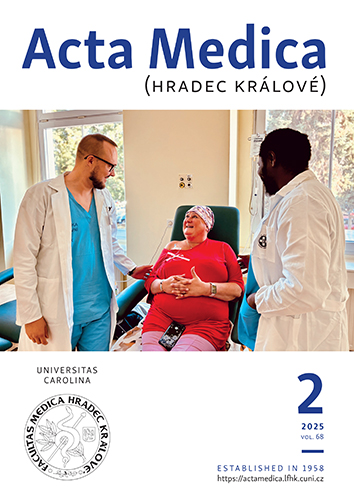ACTA MEDICA, Vol 65 No 3 (2022), 105–111
The Role of FXR-Signaling Variability in the Development and Course of Non-Alcoholic Fatty Liver Disease in Children
Yuriy Stepanov, Natalia Zavhorodnia, Inna Klenina, Olena Hrabovska, Viktoria Yagmur
DOI: https://doi.org/10.14712/18059694.2022.26
published online: 02. 02. 2023
abstract
Introduction: Genetic mechanisms among many other factors play a crucial role in the development and progression of nonalcoholic fatty liver disease (NAFLD). The farnesoid X-receptor (FXR) regulates the expression of target genes involved in metabolic and energy homeostasis, so it can be assumed that genetic variations within the NR1H4 gene, encoding FXR, can affect the development or progression of associated diseases, including NAFLD. The aim: To study the association of SNP rs11110390 NR1H4 gene with the probability of development and course of NAFLD in children. Materials and methods: 76 children aged 9–17 years and overweight were examined. According to controlled attenuated parameter (CAP) measurement (Fibroscan®502touch) children were divided into 2 groups: group 1 consisted of 40 patients with NAFLD, group 2 was composed by 36 patients without hepatic steatosis. According to genetic testing children were divided into 3 subgroups – children with CC-, CT-, TT-genotype SNP rs11110390 NR1H4 gene. Results: The frequency of TT-genotype SNP rs11110390 NR1H4 gene detection in children with NAFLD was 17.5% versus 2.8% in the control group (p < 0.05). In children with TT-genotype SNP rs11110390 NR1H4 gene the liver stiffness (p < 0.05) and CAP (p = 0.1) were higher than in patients with CC- and CT-genotypes. Patients with the TT-genotype differed from CC-genotype patients with lower levels of IL-10 (p < 0.05) and pro-inflammatory cytokine balance (p < 0.05). An increase in the concentration of taurine-conjugated bile acid fractions in the hepatic and gallbladder’s bile in children with TT-genotype SNP rs11110390 NR1H4 (p < 0.05) was demonstrated. Conclusions: SNP rs11110390 NR1H4 is associated with an increased probability of NAFLD development in children. An increase in the steatosis degree and liver stiffness in combination with increased taurine-conjugated bile acids fractions in the hepatic and gallbladder’s bile, shift in cytokine balance due to a decrease in IL-10 level in children with TT-genotype SNP rs11110390 NR1H4 were observed.
keywords: farnesoid X-receptor; single nucleotide polymorphism; nonalcoholic fatty liver disease; children

The Role of FXR-Signaling Variability in the Development and Course of Non-Alcoholic Fatty Liver Disease in Children is licensed under a Creative Commons Attribution 4.0 International License.
210 x 297 mm
periodicity: 4 x per year
print price: 150 czk
ISSN: 1211-4286
E-ISSN: 1805-9694
